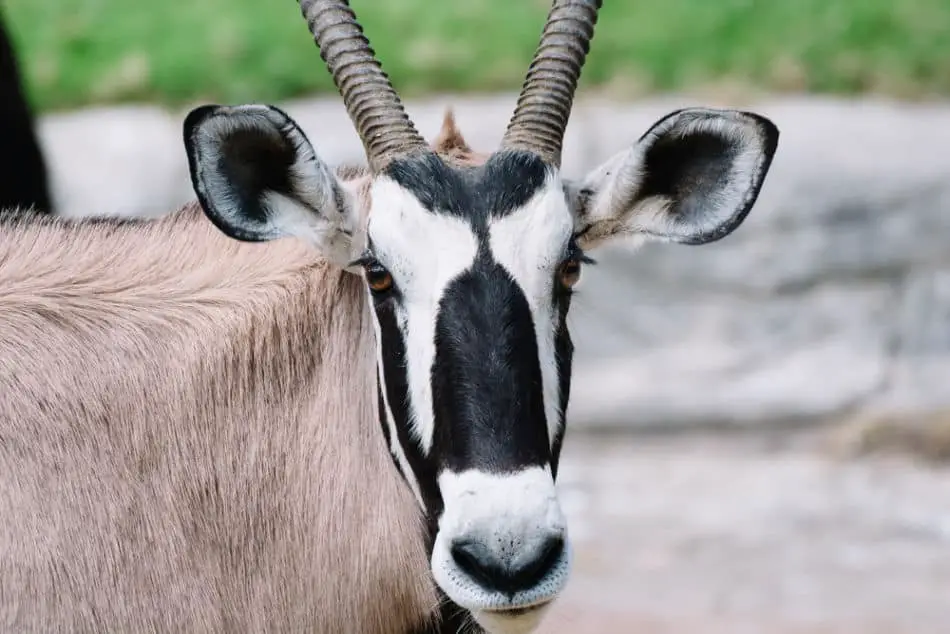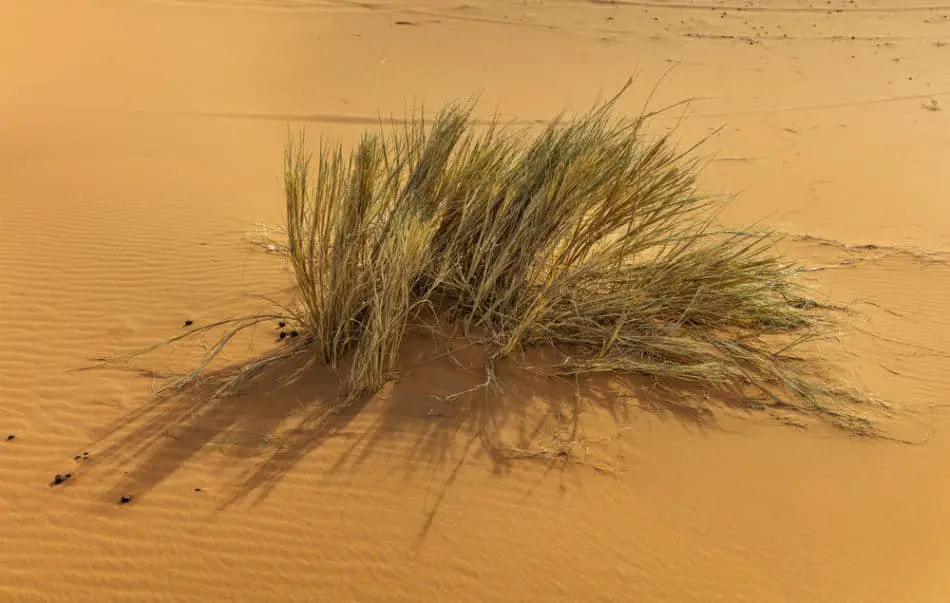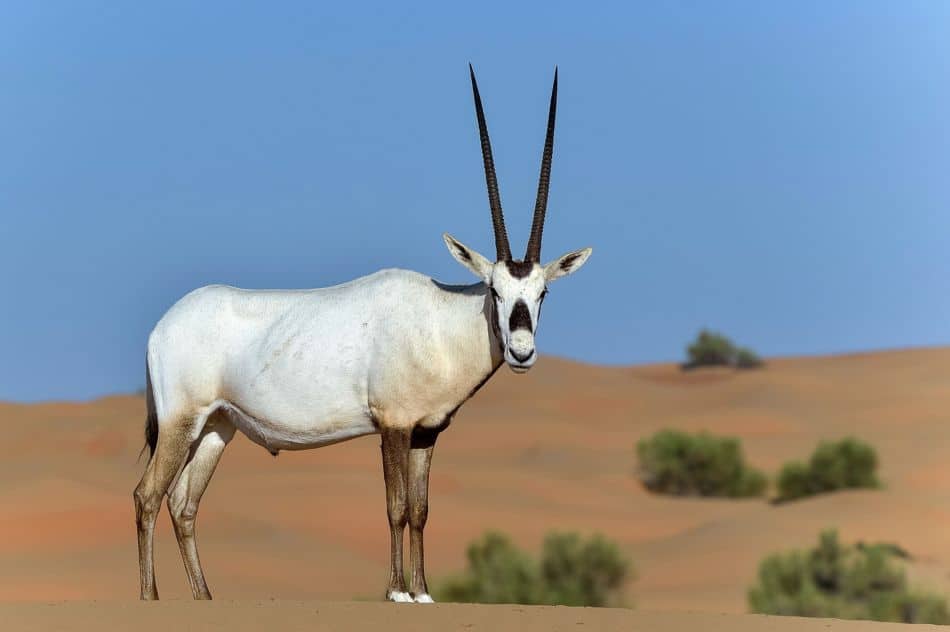When we say “Dubai”, images of luxury malls, impressive shopping scenes and magnificent skyscrapers must have conjured up in your mind. Well, it’s a fact that the world knows Dubai like this mostly but in this post, we are going to introduce a completely different gem of the region – the majestic Arabian Oryx.
The Arabian Oryx is the national animal of the United Arab Emirates (UAE). This beautiful antelope is a typical native animal found in the deserts and gravel plains all across the Arabian Peninsula, covering most parts of the Middle East region.
A Few Words About Arabian Oryx
The Arabian Oryx is undeniably one of the most prominent and largest desert animals in the Arab region. Right from ancient times, this gorgeous animal has been an important part of Arabian heritage, history and culture.
In spite of being highly adaptive to the harsh desert climate and extremely arid environment, Arabian Oryx was once extinct in the wild. Then it was reintroduced and nurtured carefully to achieve the goal of building a large semi-managed population in several sites of the UAE.
Scientific Name and Local Names
If you follow the classification chart of animals, Arabian Oryx has the scientific name of Oryx leucoryx. This species is commonly known with several local names including Maha, Baqar al Aash, Wudhaihi, Boosolah and Dishon.
Male Arabian Oryx are called buck and females are called doe. The new-born is known as the lamb or calf.
Where Does Arabian Oryx Belong In The Animal Kingdom?
- Kingdom: Animalia
- Phylum: Chordata
- Subphylum: Vertebrata
- Class: Mammalia
- Order: Artiodactyla
- Family: Bovidae
- Subfamily: Hippotraginae
- Genus: Oryx
- Species: Oryx leucoryx
What Do Arabian Oryx Look Like?

The national animal of the UAE, Arabian Oryx is almost luminous white in colour with slightly brown undersides and legs. Both males and females sport black stripes where the head meets the neck, on the forehead, on the nose and from the horn towards the mouth.

The Arabian Oryx features a typical black ornamented tail along with black-tipped ears. Both sexes have straight (sometimes little curved) and ringed horns which may grow up to 50 – 75 cm long.
A fully grown Arabian Oryx weighs approximately 65-70 kg. The height of these wild creatures ranges from 80 – 105 cm whereas the length of the body usually hovers around 150-160 cm. Females are comparatively longer and thinner than males.
The bright white coat of the Arabian Oryx not only reflects sunrays to maintain the body temperature but also creates a captivating contrast against the golden sand of the desert. The hooves of these animals are shaped like shovels and broader in shape so that they can enjoy a larger surface area while walking on the sandy terrains.
These animals are quite famous for their unbelievable stamina and poise that have inspired many Arabian poets to mention them in their creations. Thanks to the intensive reintroduction program, the population size of the Arabian Oryx is currently more than 8,000.
What Countries Do Arabian Oryx Reside?
The Arabian Oryx are found in African and Asian continents. If you want to consider the country names, then these animals are well distributed across Iraq, UAE, Egypt, Jordan, Syria, Yemen and Kuwait.
Biome And Climate Zones Suitable For Arabian Oryx
Arabian Oryx is best adapted for these biome –
- Temperate grasslands
- Desert and Xeric Shrublands
These animals are designed to survive effortlessly in Temperate and Arid climate zones. Such climate zones remain very dry and showcase extreme temperature different between day and night.
Habits and Lifestyle Of The Arabian Oryx
The Arabian Oryx is a typically gregarious species that lives in herds. These herds are made of 5 to 30 animals. Larger herds indicate good weather, better availability of resource and excellent health condition.
When the climatic condition is not that favourable and it requires extra effort to survive the tough days, the herd shrinks down and it only consists of a male, a couple of females and just their young. A few male Arabian Oryx prefer to choose a more solitary life themselves and to hold a large territory.
There is a clear hierarchy of dominance in the herd. Rank in the hierarchy is visible by the display of postures which saves herd members from serious injuries caused by sharp and long horns.
The Arabian Oryx has this strange ability to detect rainfall from a great distance. This nomadic species can travel across vast areas in search of new vegetation sprouting after intermittent rains.
These animals remain active mostly during the early hours of the day and in the late evening. During mid-day, when the temperatures are very high, Arabian Oryx take rest in groups in the shade to avoid scorching heat. Sometimes they dig depressions in the ground to take shelter in cooler sand.
What Do Arabian Oryx Eat?

Arabian Oryx are herbivores. They survive on herbs, grasses, roots as well as tubers of plants. They have an extraordinary capacity to last for days without drinking water.
Mating Habits of Arabian Oryx
The Arabian Oryx are polygynous breeders which means one male mates with many females under a single mating season. A favourable condition promotes one female to give birth to one calf a year in any month.
Most births are recorded during the months of October to May among the introduced herds of Oman and Jordan. Female Arabian Oryx start to give birth after attaining the age of at least 2.5 years. The gestation period of Arabian Oryx lasts approximately 240 days.
The Extinction and Reintroduction of The Arabian Oryx
Although Bedouin people from the Arabian Peninsula used to hunt Arabian Oryx in great number, that’s not the reason this wonderful species was forced to the Vulnerable (VU) status as per the IUCN Red list. The total decimation of these animal actually happened after World War II when motorized transport and firearms destroyed their habitats.
By 1972, the Arabian Oryx was made extinct in the wild. But an intensive reintroduction program was designed and implemented in the 90’s to revive this beautiful creature once again.
Currently, this desert species exhibits a population size of about 1,000 individuals in the wild of the UAE. In the United Arab Emirates, there are approximately 4,000 Arabian Oryx in captivity, making up more than half the percentage of the worlds population.
Where To Find Arabian Oryx in The UAE?

The below are the best places to be able to spot Arabian Oryx:
- Al Ain Zoo, Abu Dhabi – This zoo is open to the public.
- Dubai Desert Conservation Reserve – Go for a desert safari with approved tour operations to get up-close with Arabian Oryx.
- Arabian Oryx Protected Area, Abu Dhabi – This area is restricted to only authorized persons, not for general public.
- Arabian Wildlife Centre, Sharjah – This zoo is open to all.
- Breeding Centre For Endangered Arabian Wildlife – This place is not open to general public.
- Wadi Al Safa Wildlife Centre, Dubai – Not open to general visitors.
Arabian Oryx At A Glance
- Common Name: Arabian Oryx or Oryx
- Scientific Name: Oryx leucoryx
- Colour: Coated with nearly luminous white fur, the undersides and legs are somewhat brown, black stripes appear where the head meets the neck, on the forehead and nose. A prominent black ornamented tail with black-tipped ears.
- Height: 18 to 35 inches
- Length: Ranges between 5 to 7 feet in length.
- Weight: Weight varies between 70 kg to 90 kg depending on the species.
- Lifespan: Up to 20 years.
- Diet: Herbivores. Keep munching on different types of grass or roots, shrubs, woody plants, tree bark and desert cactus. They chew food several times for easy intestinal digestion.
- Cubs: Babies of the Arabian Oryx called lamb or calf.
- Pregnancy: Gestation period of 240 days with the ability to give birth to a single calf.
- Behaviour: Lives in herds that contains 5 to 30 individuals.
Interesting Facts About Arabian Oryx
- Oryx remain very alert and they have keen sight. Their defence gesture is to lower the head to point their long, sharp horns forward.
- Inside their heads, they have an unusual circulation system to cool the blood in order to survive the desert climate.
- The Arabian oryx is capable of smelling rain from miles away. The head female oryx leads the herd to search for the fresh grasses germinating after the rainfall.
- The white colour of Arabian Oryx reflects the desert heat and sunlight. On cold winter mornings, they trap the body heat in their thick undercoats to keep themselves warm. During winters, their legs get darken to absorb more heat from the sun.
- The Arabian Oryx may be related somewhere to the legend of the unicorn. Looking at them, even you can spot the similarities.
- Arabian Oryx are not fast runners but they can walk long distances. Up to 70 km in one night.
- The Arabian Oryx’s skin has no glare or reflection. Therefore, it is very difficult to see them even from a distance of just 100 meters. They appear almost invisible.
Conclusion
Thank you for reading about the Natinoal Animal of the UAE, The Arabian Oryx.
For everything Dubai and Abu Dhabi make sure you head for our other articles here. Also, follow us on Pinterest and subscribe to our Youtube channel too.

